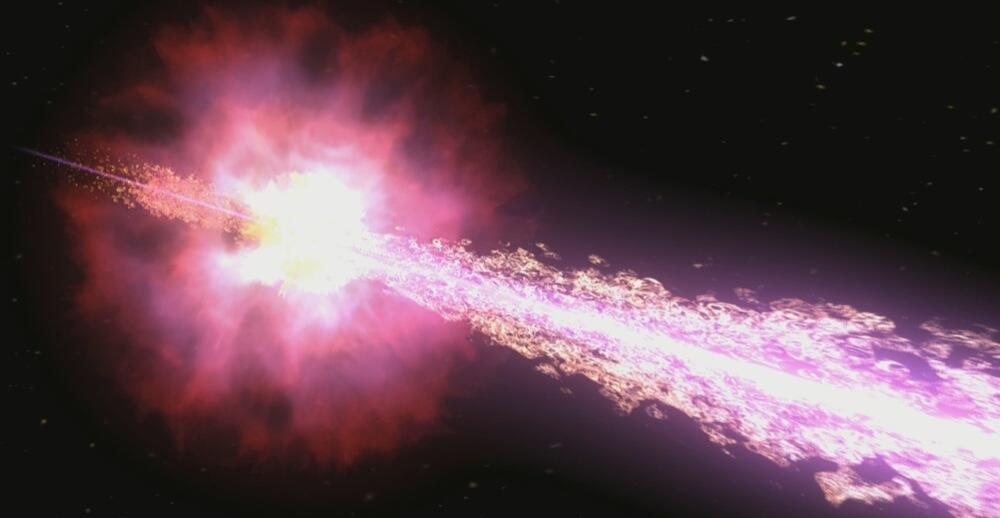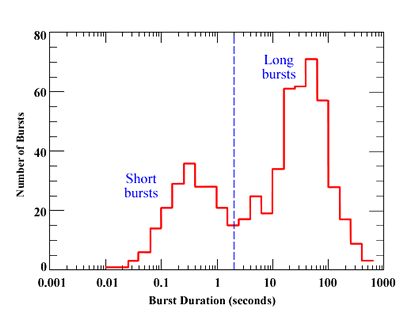Introduction
Gamma-ray bursts (GRBs) refer to short-lived, highly energetic explosions that occur in distant galaxies. According to scientists, they are the most energetic and brightest electromagnetic emissions that can last between a few milliseconds and several minutes. A gamma-ray flash is usually followed by a glow that occurs at longer wavelengths that include infrared, ultraviolet, and radio. Studies have suggested that the intense radiation generated during a burst originates from the collapse of a high-mass star, which results in the formation of either a black hole or a neutron star. GRBs are unique natural phenomena because they are partially understood and produce high amounts of energy. They release radiation stronger than the Sun’s and they occur billions of light years away from the Earth.
History
The history of gamma-ray bursts can be traced back to the 1960s. The United States had launched Vella satellites into space to detect gamma radiation released by nuclear weapons propelled into space during military tests (Zhang 14). The satellites were launched in fear that the Soviet Union would conduct nuclear weapons tests. In 1967, the US detected a burst of gamma radiation that surpassed the energy quantity that could be emitted by nuclear weapons (Zhang 14). Further studies and evaluations by the Los Alamos National Laboratory revealed that the intense energy emanated from distant locations on the universe, thus ruling away the possibility of a terrestrial origin.
Causes
Several theories have been suggested to explain the cause of GRBs. One of the theories postulates that the bursts originate from the explosions of massive stars that form black holes (Zhang 25). This hypothesis is based on the observation of afterglows that are associated with certain gamma-ray bursts, which occur at different wavelengths. They are characterized by distinct changes in light curves over time (Choi). This theory was confirmed after astronomers studied the afterglow of several bursts and observed traits of a supernova (Branch and Wheeler 72). Recent studies have led to insights that have advanced the study and comprehension of the phenomenon.
For example, the variability of light curves suggests that not all GRBs are caused by supernova (Zhang 26). Another theory suggests that GRBs emanate from the merging of neutron stars, which are dense bodies that contain the Sun’s mass, and whose collisions result in the emission of intense radiation. In 2018, the Fermi satellite recorded gravitational waves that originated from the merging of two neutron stars, confirming the theory that short bursts of gamma rays can be caused by merging neutron stars.
Emission Mechanisms
Research studies are still underway to explain the mechanism through which energy emitted from gamma-ray bursts is converted into radiation. This phenomenon is poorly understood but astronomers are in the process of developing a model to offer a satisfactory explanation (Branch and Wheeler 55). It is difficult to clarify the physical processes that cause the diversity of light curves and spectra, which are characteristic of GRBs (Choi).
Moreover, the efficiency of energy conversion into radiation is not well comprehended. The afterglow is a distinct feature of GRBs that occurs at low-energy wavelengths (Zhang 22). Some of them are linked to the supernova explosions that are referred to as hypernova. Regardless of the burst’s progenitor, the energy released exceeds that of a supernova explosion.

Properties
The duration of bursts lasts between a few milliseconds and several minutes. The light curves are irregular, vary with energy, and can be separated into numerous asymmetric pulses (Zhang 43). They exhibit different patterns that have varying pulses. Some GRBs have a softer, antecedent emission element that is distinct from the major burst (Branch and Wheeler 64).
Types
Astronomical studies have shown that there are two main types of GRBs depending on their duration. They include short-duration and long-duration. Short-duration bursts last for an average of 300 milliseconds (Zhang 31). Astronomers have argued that they are caused by the merger of two neutron starts to form a black hole. Alternatively, they can be the outcome of the merger of a black hole and a neutron star (Choi). Long-duration GRBs last for an average of 30 seconds, though others can go on for several minutes (Zhang 33). These bursts are linked to the explosion of huge stars in certain supernovas and they have the brightest afterglows.

Effects
Researchers have suggested that mass extinction on Earth could have resulted from the effects of a gamma-ray burst. They have argued that the GRB phenomenon could be used to explain the Fermi paradox, which centers on the probability of the existence of extraterrestrial civilization (Choi). Many astronomers have postulated that GRBs might have destroyed planets that could support life (Zhang 46).
Scientists have stated that if a GRB occurred within the Milky Way, it would cause massive damages on Earth by destroying the ozone layer (Klein and Fletcher 53). In addition, they could cause radiation sickness due to the release of cosmic rays. However, these effects have not been scientifically confirmed. Short-duration bursts occur more often than long-duration ones even though they pose insignificant life-threatening risks because they contain low levels of radiation that cannot annihilate life on Earth (Klein and Fletcher 54).
Researchers have attributed the Ordovician extinction that took place on Earth approximately 440 million years ago to a high-radiation gamma-ray burst (Klein and Fletcher 57). Scientists have also investigated the potential effects of a GRB on other parts of the Milky Way galaxy. Regions near the centre of the galaxy have densely packed stars that could merge to cause gamma-ray bursts. The risk is higher in regions that lie around the galaxy’s core.
Theories have been put forward to suggest that only 10 percent of galaxies in the universe can support life as it is on Earth because of the high risks of GRBs (Klein and Fletcher 64). In that regard, life could have existed in those galaxies in the past 5 billion years because galaxies were smaller and more prone to mass extinctions that larger galaxies.
Conclusion
Gamma-ray bursts are violent explosions that emit intense radiation from the merger of massive stars that result in the formation of black holes. They have been described as the most luminous explosions in the universe because they emit radiation across the whole electromagnetic spectrum. GRBs can be either short-duration or long-duration. These two types differ in their origin and characteristics. Short-duration bursts are caused by the death of massive stars while short-duration bursts result from the activities of neutron stars and black holes. The bursts are highly powerful because they produce more energy than the Sun or the entire Milky Way galaxy, which is emitted in the form of radiation rather than optical light. This radiation can be destructive if a burst occurs in the Milky Way galaxy.
References
Branch, David, and Craig Wheeler. Supernova Explosions. Springer-Verlag, 2017.
Choi, C. Q. “Did Deadly Gamma-Ray Burst Cause a Mass Extinction on Earth?” LiveScience. Web.
Klein, Ulrich, and Andrew Fletcher. Galactic and Intergalactic Magnetic Fields. Springer International Publishing, 2015.
Zhang, Bing. The Physics of Gamma-Ray Bursts. Cambridge University Press, 2018.